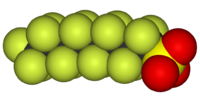
Photo from wikipedia
Abstract Per- and polyfluoroalkyl substances (PFAS) are pollutants have attracted major concern due to their high persistence and bioaccumulation. They are causing increasingly serious epidemiological problems in many communities globally… Click to show full abstract
Abstract Per- and polyfluoroalkyl substances (PFAS) are pollutants have attracted major concern due to their high persistence and bioaccumulation. They are causing increasingly serious epidemiological problems in many communities globally due to consuming PFAS-contaminated water sources. Necessarily, the behavior of PFAS in water and wastewater needs to be understood better. This study attempts to comprehensively review, analyze and discuss PFAS based on the following key aspects: (i) sources, (ii) occurrence in water and wastewater, (iii) transformation, fate and migration, and (iv) remediation technologies. Studies indicated that modern water and wastewater treatment plants cannot deal completely with PFAS and in some cases, the removal efficiency is minus -3500-fold. The main reasons are the high hydrophobicity of PFAS and presence of PFAS precursors. Precursors can account for 33–63% of total PFAS concentration in water and wastewater. Detection and identification of precursors are challenging due to the requirement of advanced analytical instrument and standard chemicals. Several technologies have been developed for PFAS remediation involving two main mechanisms: separation-concentration and destruction. The most widespread in-use technology is adsorption because it is reasonably affordable. Anion exchange resin and synthesized materials are the most effective sorbents having a sorption capacity of 100–2000 mg PFAS/g sorbent, effective within a few hours. The destruction technology such as plasma can also be a promising one for degrading PFAS to below health-based standard in 1 min. However, plasma is costly and not yet ready for full scale application.
Journal Title: Journal of water process engineering
Year Published: 2020
Link to full text (if available)
Share on Social Media: Sign Up to like & get
recommendations!